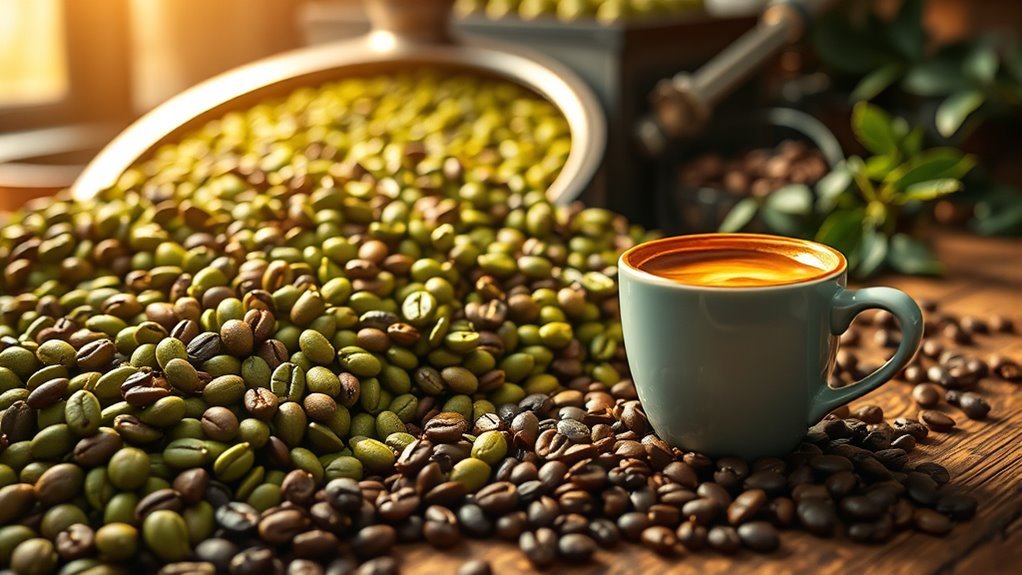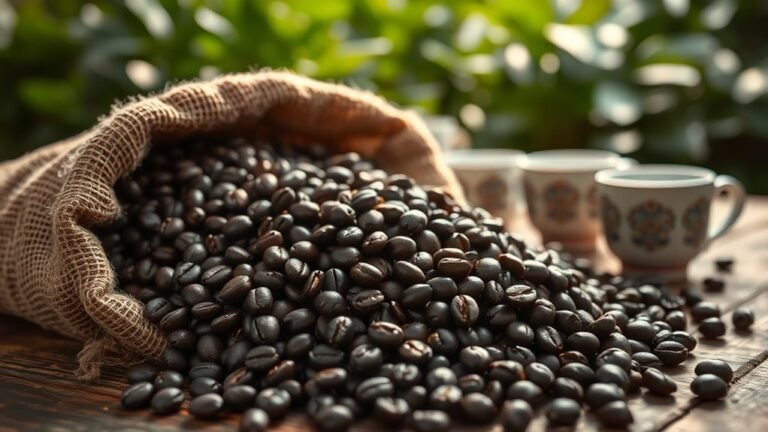The Art of Coffee Roasting: From Green Beans to Brewed Cup
You control every step of coffee roasting, transforming green beans into rich, aromatic brews through precise heat application and varietal mastery. Understanding bean types like Arabica or Robusta shapes your flavor foundation, while careful monitoring of heat triggers Maillard reactions that develop acidity, sweetness, and body. Proper equipment guarantees consistent temperature and airflow, essential for crafting your roast profile. Master these techniques, and you reveal the complexity behind every perfect cup, ready to explore deeper nuances.
Understanding Coffee Bean Varieties

When you immerse yourself in coffee roasting, understanding the distinct varieties of coffee beans is essential because each type brings unique chemical compositions and flavor potentials that directly influence your roast profile. You’ll quickly notice the fundamental differences between Arabica vs Robusta: Arabica beans, prized for their nuanced acidity and broad aromatic complexity, contain less caffeine and sugar, allowing for a sweeter, more delicate roast. Robusta, with its higher caffeine and chlorogenic acid content, delivers a bolder, more bitter profile that’s perfect for robust, intense flavors. Embracing Single Origin Coffee further refines your craft, as these beans offer traceable terroir effects—soil, altitude, and climate—that manifest in distinct taste signatures. Mastering these varietal traits empowers you to craft roasts that celebrate freedom in flavor expression.
The Science Behind Roasting
When you apply heat to coffee beans, a complex series of chemical reactions transform their structure, releasing essential flavors. Understanding how heat influences Maillard reactions and caramelization is key to controlling the roast profile. This process shapes the coffee’s aroma, acidity, and body, turning raw beans into a rich sensory experience.
Chemical Changes Explained
The transformation coffee beans undergo during roasting is a complex symphony of chemical reactions that fundamentally alter their composition and flavor profile. As you control the roast profile, the Maillard reaction ignites, driving the formation of rich flavor compounds and deepening the acidity balance. Simultaneously, the caramelization process breaks down sugars, crafting sweet, nuanced aroma compounds that define the coffee’s sensory evaluation. These reactions reshape the beans’ chemical composition, revealing the latent potential within green beans. Every stage of roasting refines this alchemy, demanding precision and passion. Understanding these chemical changes empowers you to tailor the roast, embracing freedom to highlight desired notes or textures. By mastering this science, you transform raw beans into a brewed cup bursting with complexity and character.
Heat’s Role Detailed
Although heat might seem straightforward, its role in coffee roasting is both intricate and essential, dictating every chemical and physical transformation within the bean. You’ll find that precise heat application controls the rate at which moisture evaporates and complex Maillard reactions unfold. Roasting temperatures typically range between 370°F and 540°F, but the timing and consistency of heat delivery shape the bean’s internal structure and density. As you manipulate heat, you influence expansion, cracking events, and the breakdown of sugars and acids. Each increment in temperature shifts the balance between caramelization and pyrolysis, demanding your acute attention to avoid scorching or underdevelopment. Mastering heat application isn’t just about reaching a target temperature—it’s about guiding the bean through a carefully orchestrated thermal journey that reveals its full potential.
Flavor Development Process
Since flavor development hinges on intricate chemical reactions, you’ll find that understanding the science behind roasting is essential to revealing a coffee bean’s aromatic potential. As you apply heat, Maillard reactions and caramelization transform sugars and amino acids, crafting complex flavor profiles unique to each roast level. These chemical changes evolve swiftly, demanding precise control to release desirable notes without tipping into bitterness. Sensory evaluation becomes your compass, guiding adjustments by detecting subtle shifts in acidity, body, and aroma. By mastering this process, you harness freedom—the liberty to coax out the fullest expression from each bean. Embrace this scientific art, and you’ll transcend mere roasting, shaping a sensory journey that captivates and delights with every brewed cup.
Exploring Different Roast Levels
When you explore coffee roasting, understanding different roast levels is essential because each stage profoundly influences flavor, aroma, and chemical composition. You start with a light roast, where the beans reach internal temperatures around 356°F to 401°F. This preserves origin-specific characteristics—bright acidity, complex floral notes, and higher concentrations of chlorogenic acids. As you push toward medium and medium-dark roasts, Maillard reactions and caramelization deepen, balancing acidity with sweetness and fuller body. Finally, the dark roast stage surpasses 464°F, often reaching the second crack, developing bold, smoky flavors and diminished acidity, with oils emerging on the bean surface. By mastering these roast levels, you control not just taste but the very essence of coffee’s soul, giving you the freedom to craft your perfect brew.
Essential Roasting Equipment

Mastering coffee roasting demands the right equipment, as each tool directly impacts your control over temperature, airflow, and roast consistency. Your cornerstone is a high-quality roasting machine—precision-engineered to maintain stable temperature control, essential for revealing each bean’s potential. Look for machines with adjustable airflow to influence roast development and chaff removal efficiently. A reliable temperature probe and digital display empower you to monitor and tweak heat in real time, granting full command over the roast profile. Additionally, a sturdy cooling tray guarantees rapid bean cooling, halting chemical reactions instantly to preserve desired flavor notes. Investing in calibrated roasting machines with fine temperature control isn’t just a technical necessity—it’s your gateway to freedom, enabling you to craft unique, consistent coffee expressions every time.
Step-by-Step Roasting Process
Before you ignite the roaster, you’ll need to meticulously prepare your green coffee beans to guarantee uniformity and ideal moisture content. As the roast progresses, you must closely monitor the critical stages—like the first crack and color changes—because each moment shapes the flavor profile. Once the roast reaches perfection, rapid cooling and proper storage are essential to lock in freshness and prevent staling.
Preparing Green Coffee Beans
Start by carefully selecting green coffee beans, as their quality directly influences the final roast profile. Your green bean sourcing should prioritize beans with consistent size, moisture content, and origin to guarantee uniform roasting. Conduct a thorough quality assessment—inspect beans for defects like insect damage, mold, or discoloration. Use tools like moisture meters and color sorters to refine your selection, assuring peak freshness and density. Proper storage is essential; keep beans in a cool, dry, and dark environment to preserve their chemical integrity. Handling each batch with this meticulous approach grants you control over the roasting journey, empowering your freedom to craft distinct flavor profiles. Preparing your green beans with precision sets the foundation for a roast that’s both technically sound and expressively yours.
Monitoring Roast Stages
How do you know when your coffee beans have reached their ideal roast? It’s all about mastering your roast profile through precise monitoring techniques. As you roast, you’ll track temperature changes, listen for the first and second cracks, and observe color shifts—each indicator revealing critical stage changes. You’ll rely on real-time data, adjusting heat and airflow to craft the flavor you want. Monitoring the Maillard reaction’s progression and moisture loss guarantees you hit that sweet spot where acidity, body, and aroma harmonize. It’s a dance between science and intuition, giving you the freedom to create unique profiles. By honing your monitoring skills, you gain control and confidence, transforming raw beans into a cup that truly reflects your roasting artistry.
Cooling and Storage Methods
Once your beans reach the desired roast level, rapid cooling becomes essential to halt the roasting process and preserve the nuanced flavors you’ve developed. Effective cooling techniques, such as air cooling or using a cooling tray, quickly reduce bean temperature, preventing over-roasting and flavor degradation. After cooling, selecting proper storage containers is vital to maintain freshness and aromatic integrity by limiting oxygen, moisture, and light exposure.
| Cooling Techniques | Storage Containers |
|---|---|
| Air cooling | Airtight glass jars |
| Cooling trays with fans | Vacuum-sealed bags |
| Water quenching (rare) | Opaque ceramic containers |
| Stirring during cooling | Food-grade plastic containers |
| Quick heat dissipation | One-way valve bags |
Mastering these steps grants you full control over your roast’s final profile, revealing coffee’s true freedom.
Tips for Perfecting Your Roast
Although mastering coffee roasting demands patience and precision, refining your technique can dramatically enhance flavor complexity and consistency. To perfect your roast, start by meticulously developing and documenting roast profiles for each bean variety. This allows you to control time-temperature curves, ensuring ideal Maillard reactions and caramelization without overdevelopment. Pay close attention to flavor balancing—adjusting heat application to emphasize desired notes like acidity, sweetness, or body. Use small batch tests to isolate variables and taste frequently during development. Consistency is key: calibrate your roaster regularly and monitor environmental factors that affect heat transfer. Don’t hesitate to experiment with airflow and drum speed to influence bean agitation and evenness. Ultimately, embracing these technical nuances empowers you to craft a roast profile that expresses each bean’s unique character with freedom and precision.
Frequently Asked Questions
How Does Altitude Affect Coffee Bean Flavor?
Imagine climbing a mountain where every step reveals a new view—altitude impacts coffee just like that ascent shapes your perspective. At higher elevations, cooler temperatures slow bean maturation, allowing sugars and acids to develop complex flavor profiles you crave. This means the coffee you brew carries vibrant acidity and intricate notes. So, when you sip that cup, you’re tasting freedom captured in altitude’s delicate balance, revealing a truly elevated experience.
What Are the Best Storage Methods for Green Beans?
To preserve green beans’ quality, you need airtight containers that maintain humidity control and temperature stability. Avoid moisture and heat fluctuations, which degrade beans’ flavor precursors. Store them in cool, dark places—ideally between 60-70°F with 60-65% humidity. This environment secures freshness, giving you the freedom to roast on your schedule without sacrificing complexity or aroma. Proper storage empowers you to access the beans’ full potential when you’re ready.
Can Home Roasting Reduce Caffeine Content?
Think of caffeine extraction like a delicate dance—roasting techniques play the lead role. When you roast coffee at home, you’re controlling heat and time, which subtly alters caffeine levels. While roasting does cause some caffeine degradation, it’s minimal; caffeine is quite heat-stable. So, your home roasting won’t drastically reduce caffeine content, but mastering these techniques lets you craft unique flavors while embracing the freedom to experiment with your brew.
How Do Environmental Factors Influence Roasting Consistency?
You’ll find that humidity levels and temperature fluctuations play a huge role in roasting consistency. If humidity’s high, beans absorb more moisture, slowing heat transfer and causing uneven roasts. Temperature swings disrupt the steady development of flavors, making it tough to replicate your ideal profile. To truly master roasting freedom, you’ve got to control these factors meticulously, ensuring your beans roast evenly every time, revealing the fullest potential in each batch.
What Are the Health Benefits of Freshly Roasted Coffee?
Did you know freshly roasted coffee boasts up to 30% higher antioxidant properties than stale beans? When you drink it soon after roasting, you’re maximizing these powerful compounds that combat oxidative stress. Plus, the volatile oils responsible for mental alertness are at their peak, enhancing focus and cognitive freedom. By choosing freshly roasted coffee, you’re fueling your body and mind with a potent, natural boost that supports your active, liberated lifestyle.






